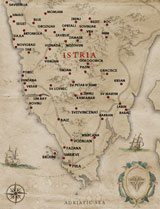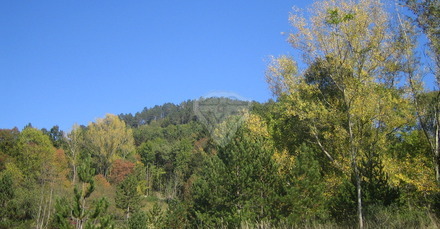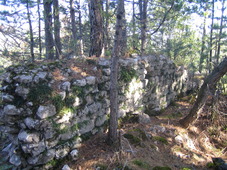to enlarge


or choose the place
from the menu below
 Rome |
 Byzantium |
 Venice |
 Vienna |
 Brioni |
 Smrikve |
 |
 |
Raspor is a small village located in a beautiful mountainous valley, 693 meters above sea level to the north-east of Buzet. It has today only 17 inhabitants but historically this place was an important Venetian military seat. From this place, the Venetian Captains of Pasenatico, known as Raspor's Captains, managed the whole Istrian hinterland.





This small village was for over hundred years one of the most important Istrian villages during the Venice Republic period.
There is not much left that remind us of that period. The ruins of the well-known Raspor fortress are located about 600 meters to the north of the Raspor village on the Gradina hill, 829 meters high hilltop.
To visit the ruins you have to leave the car in Raspor village and take the road that you will find to the left of the St. Nicholas Church. It is known that this Church was named for the first time in 1385 and was reconstructed in 1585 and later in 1814.
 Take the road that goes to the left of the church and when you arrive in front of Gradina
hill you would need a guide to take you up. The ruins can be reached by a path climbing up to the hill and the access is not
easy due to the thick vegetation.
Take the road that goes to the left of the church and when you arrive in front of Gradina
hill you would need a guide to take you up. The ruins can be reached by a path climbing up to the hill and the access is not
easy due to the thick vegetation.
In 1511 the fortress was destroyed for the last time by the Venetians and after that they decided to move Raspor’s Captains base to Buzet. The Captains continued to be named Raspor’s Captains until the fall of Venice.
Raspor was a significant strategic outpost. It is located in the Cicarija hillsides and all the roads that connected central Istria with the Pre-Alpine hinterland could have been controlled from there.
The place was inhabited in prehistory. As I already said the Croatian part of Istria has over 350 prehistoric hill fort settlements, and Raspor is one of them.
The village became important during the Roman period and this is the only village in Cicarija where large amount of Roman money has been found.
After the fall of the Roman Empire, Raspor was destroyed and abandoned, although a Byzantine garrison was kept there. During the Franks period, around year 1000, it was again a fortified village.
Raspor’s fortress was named for the first time in 1264, when the first administrator known as Filippo di Raspo, a vassal of the Counts of Gorizia, was mentioned. In that period Rospor belonged to the Aquileia Patriarch and was governed, in the name of the Patriarch, by administrators from the family of Counts of Gorizia.
As soon as the Venetian Republic started to expand its possessions in Istria, Raspor became more and more important. The Venetians used to call Raspor the key of the whole Istria “Clavis totius custodiae Histriae”.